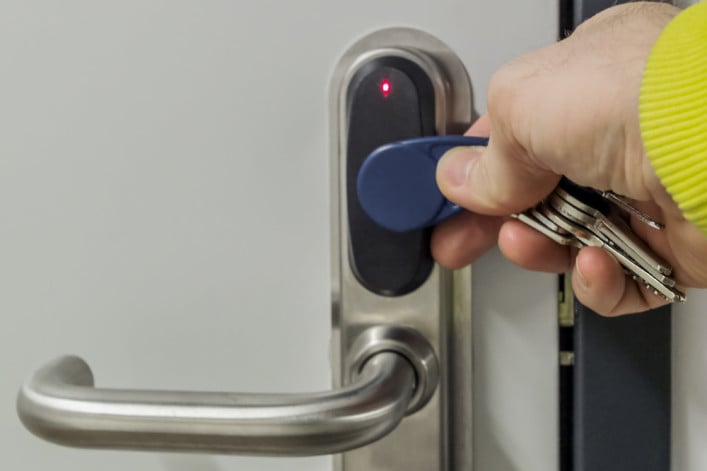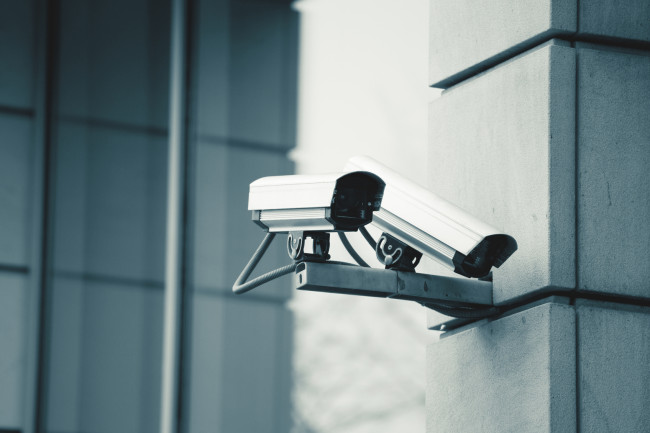Heads up rent-stabilized tenants: Key fob systems can track your comings and goings

There's the initial headache of getting a new key, and then there's the data trail it leaves.
iStock
If your building is rent-stabilized and the lock on the lobby door has been switched from a regular key to an electronic key fob system, you may not have thought much about it beyond being annoyed by having to pick up a new key from the landlord's office. But what many tenants in this situation may not know is that key fob systems are an increasingly popular tool in building owners' arsenals to try to track the comings and goings of renters.
[This story was first posted in October 2017, and is being revisited in case you missed it.]
Key fobs are small plastic discs that attach to key chains. The technology, which allows residents to buzz into buildings, works much like a key card commonly used in office buildings.
Changing the front locks to a new system that relies on fobs, which are hard to duplicate, is a way of sorting out who's actually living in the building, since it forces residents to come in person to pick up the new keys. It's also a way for landlords to ask for additional personal information about residents. And if a leaseholder is no longer living in a given apartment, navigating the switch may be tough for those who remain.
In addition, each fob has a unique identifier that the system can log every time it's used. In other words, your new key is being used to generate a database showing the dates and times that you entered your building. This comes in handy for landlords, because one of the few ways that they can legally get rid of rent-stabilized tenants and increase rents is by proving that a tenant is not using an apartment as his primary residence. What legally constitutes a primary residence is complicated, but at its most basic, it means spending more than half of a given year in the place.
If you were away—or lost your keys for an extended period—the data generated by key fobs could provide a way for landlords to argue that you're not entitled to stay in your apartment. It is by no means a surefire way of getting you out, though. For more of an idea of what rights rent-stabilized tenants have in dealing with key fobs, here are some pointers.
Installing key fob locks isn't by itself a justification for a rent hike
The Division of Housing and Community Renewal, which regulates rent-stabilized buildings, said in 2001 that a new electronic key card system could not be considered a major capital improvement, which allows landlords to increase rents building-wide based on a percentage of the cost of the work. It could potentially be considered an MCI, according to DHCR, if done in conjunction with other work such as replacing the lobby door, or with the consent of over three quarters of tenants.
Landlords must provide new key fobs to occupants at no charge
DHCR has ruled at various times that landlords have to provide new key fobs for free to all lawful occupants of rent-stabilized buildings that have undergone the change-over. They don't always make it easy, though.
"When tenants [have to] get the key fobs, that becomes a royal pain," says Sue Susman, president of the Central Park Gardens Tenant Association and administrator of housing-activist email lists. "Frequently they have to come in in person and provide identification that they otherwise wouldn’t be required to provide to a landlord."
Lawful occupants include leaseholders as well as relatives, roommates, and approved sub-tenants. DHCR has said that children over age 10 are eligible to get keys. In 2010, the agency ruled that landlords also have to provide up to four extra key cards for renters' employees or guests at no additional cost, and that landlords cannot use the transition to solicit new details about residents such as driver's license numbers or social security numbers.
If people lose key cards, DHCR has ruled that it is legal for landlords to charge up to $25 per replacement. Still, landlords often try to restrict key fob access, and charge for them when they should be free.
"In many buildings landlords are not familiar with those rules and are still trying to charge tenants for key fobs beyond that," Susman says.
Landlords have to have a backup plan
Regulators have ruled that for new electronic entry systems to not constitute a reduction of services for which tenants can get a break on rent, landlords must accommodate renters with religious restrictions around electronics use, such as Orthodox Jews observing Shabbat, and also have a backup plan for letting people in if the power goes out.
Key fob data is just part of a non-primary residence case
Key fob data is typically just one piece of a picture that a landlord can try to paint of a tenant living elsewhere.
Other facts that landlords can use, according to Michael Kozek, a lawyer at the firm Ween & Kozek: "Employees haven’t seen you. They do a search of other addresses associated with a person’s name and you have another address out there. They put that all in a petition to start the case."
Another common, and powerful form of evidence in these cases is surveillance footage showing someone else entering your apartment regularly in your absence.
Kozek explains, "In the course of trying to resolve the case, landlords will typically say to the tenants’ attorneys, ‘We have this video or key fob information.’"
However, fob data is not all that useful on its own.
"Key fobs are not so helpful in a non-prime if not lined up with camera data, right?" landlord-tenant attorney Michelle Itkowitz of the firm Itkowitz PLLC told Brick in an email, stressing that tenant representation makes up a large part of her practice. "Because you can just hand the fob to someone else. So…"
Similarly, it's possible in busy buildings to get in regularly by having someone hold the door open for you, in which case you wouldn't log a fob entry.
Also, if a non-primary residence case actually gets to court, the data has to have been maintained in such a way that it's admissible as evidence. Nevertheless, the more methods landlords can use to back up their argument, the happier they tend to be.
There are legitimate reasons to not live in your apartment full-time
Some reasons for staying away from your rent-stabilized apartment are recognized as legitimate by the courts, but landlords can still use your paper trail against you, so it's important to keep all your official business tied to your long-term home.
The concept that will be crucial to prove if you're away—whether you're studying, caring for an elderly relative, or touring with your band—is an intent to return, according to Kozek.
Susman relates the story of a long-term tenant who had lived with her daughter in Susman's Upper West Side complex for over 40 years. The tenant's mother died and left her a house upstate.
"In the few weeks before Tenant A can sell the house, [the management company] says, 'You don’t live in the apartment. You own a house upstate, and your daughter isn’t even a tenant here,'" Susman says. "This obviously didn't even involve the technology we're talking about. Ultimately [the tenant and her daughter] were able to prevail."
To head off this sort of disingenuous eviction attempt, Kozek recommends keeping records of everything related to your time away: school records, your parents' medical records, plane tickets, and the like.
"The key thing is to document everything," he says. "And in addition to that, maintaining all of the normal residential documentary ties. Tax returns, driver’s license, voter registration, bank statements, utility records, all of that stuff needs to stay with the apartment listed as the primary address. Because the rent stabilization code permits periods away for temporary purposes, and an intent to return to the apartment has to be shown through those documents."
Also, he adds, don't try to profiteer on your apartment. That means no Airbnb, and no market-rate sublets, tempting as they may be.
You Might Also Like





























